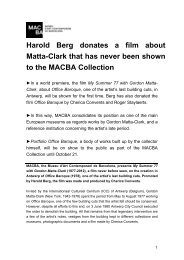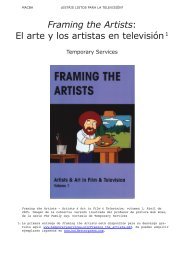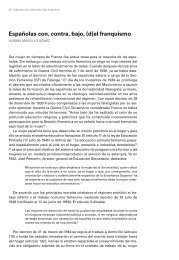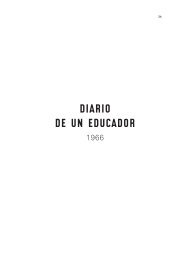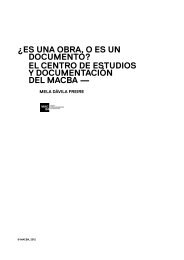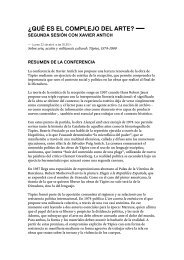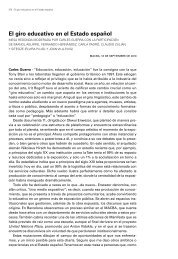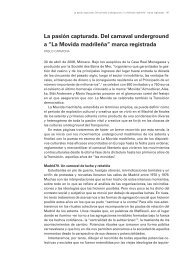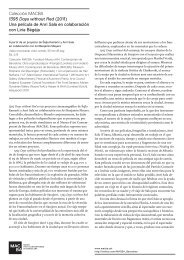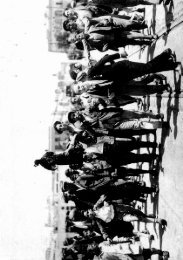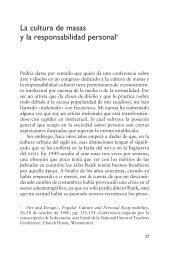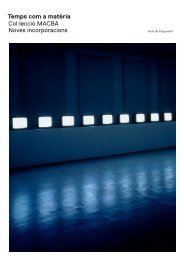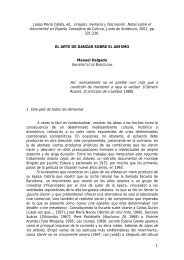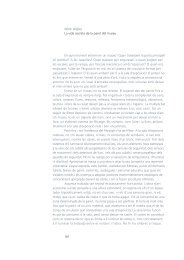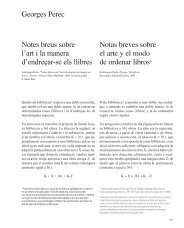Chance, Indeterminacy, Multiplicity - Macba
Chance, Indeterminacy, Multiplicity - Macba
Chance, Indeterminacy, Multiplicity - Macba
Create successful ePaper yourself
Turn your PDF publications into a flip-book with our unique Google optimized e-Paper software.
John Cage classes at the New School for Social Research, 1958<br />
(left to right: John Cage, George Brecht, Al Kouzel, Jackson Mac Low, John Cage,<br />
Al Hansen, center, and Allan Kaprow, back wall)<br />
29. As Pritchett notes, “The sounds<br />
of the concerto are both independent<br />
(in the way they occur in time) and<br />
simultaneous (in the way they exist in<br />
the chart).” (Pritchett, p. 75). Importantly,<br />
Cage introduced means of retiring<br />
and replacing sounds within the chart<br />
technique of Concerto for Prepared Piano<br />
and Chamber Orchestra. Nevertheless,<br />
at any given moment, the charts were<br />
static and complete. See Cage’s comments<br />
to Boulez in Nattiez, (ed.), p. 94.<br />
30. The Concerto profoundly altered<br />
Cage’s notion of musical continuity;<br />
nonetheless, he employed several<br />
means by which to produce transpositions,<br />
symmetry, and other correspondences.<br />
See Bernstein, pp. 195–96<br />
and 202–3.<br />
charts, in the eight-by-eight configuration of the I Ching, which<br />
contained arrays of simple moves interspersed with empty cells<br />
representing silences. Cage then tossed coins to obtain the<br />
hexagrams by which to read these additional charts in order to<br />
determine the moves to be made on the one containing sounds.<br />
Since the charts Cage used in composing Concerto for Prepared Piano<br />
and Chamber Orchestra included already complete and precisely<br />
notated sound complexes, composition essentially consisted in<br />
using chance operations to determine the sequencing of the sounds.<br />
Thus, to a certain extent, the Concerto is a linear equivalent of the<br />
charts that, at any given moment, represent the totality of available<br />
sounds. 29 In this respect, Cage’s procedure had not advanced all<br />
that far beyond Duchamp’s or Tzara’s random drawing of materials<br />
out of a hat or bag. 30 In Music of Changes, by contrast, Cage’s separation<br />
of the sound’s various components into multiple charts – one<br />
containing sonorities, one containing durations, and one containing<br />
dynamics – allowed him to surpass the limitations of compositional<br />
preconception not merely in the sequencing of the sounds, but in<br />
their very identity. More than simply arranged according to the laws<br />
of chance, each defining parameter of every acoustical event within<br />
Music of Changes was determined by chance operations.<br />
217



